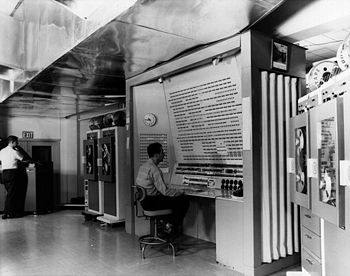
BRLESC
Encyclopedia

United States Army
The United States Army is the main branch of the United States Armed Forces responsible for land-based military operations. It is the largest and oldest established branch of the U.S. military, and is one of seven U.S. uniformed services...
's Ballistics Research Laboratory (BRL) at Aberdeen Proving Ground
Aberdeen Proving Ground
Aberdeen Proving Ground is a United States Army facility located near Aberdeen, Maryland, . Part of the facility is a census-designated place , which had a population of 3,116 at the 2000 census.- History :...
with assistance from the National Institute of Standards and Technology
National Institute of Standards and Technology
The National Institute of Standards and Technology , known between 1901 and 1988 as the National Bureau of Standards , is a measurement standards laboratory, otherwise known as a National Metrological Institute , which is a non-regulatory agency of the United States Department of Commerce...
(NIST), and was designed to take over the computational workload of EDVAC
EDVAC
EDVAC was one of the earliest electronic computers. Unlike its predecessor the ENIAC, it was binary rather than decimal, and was a stored program computer....
and ORDVAC
ORDVAC
The ORDVAC or Ordnance Discrete Variable Automatic Computer, an early computer built by the University of Illinois for the Ballistics Research Laboratory at Aberdeen Proving Ground, was based on the IAS architecture developed by John von Neumann, which came to be known as the von Neumann architecture...
, which themselves were successors of ENIAC
ENIAC
ENIAC was the first general-purpose electronic computer. It was a Turing-complete digital computer capable of being reprogrammed to solve a full range of computing problems....
. It began operation in 1962.
BRLESC was designed primarily for scientific and military tasks requiring high precision and high computational speed, such as ballistics
Ballistics
Ballistics is the science of mechanics that deals with the flight, behavior, and effects of projectiles, especially bullets, gravity bombs, rockets, or the like; the science or art of designing and accelerating projectiles so as to achieve a desired performance.A ballistic body is a body which is...
problems, army logistical problems, and weapons systems evaluations. It contained 1727 vacuum tube
Vacuum tube
In electronics, a vacuum tube, electron tube , or thermionic valve , reduced to simply "tube" or "valve" in everyday parlance, is a device that relies on the flow of electric current through a vacuum...
s and 853 transistors and had a memory
Computer storage
Computer data storage, often called storage or memory, refers to computer components and recording media that retain digital data. Data storage is one of the core functions and fundamental components of computers....
of 4096 72-bit
Bit
A bit is the basic unit of information in computing and telecommunications; it is the amount of information stored by a digital device or other physical system that exists in one of two possible distinct states...
words. BRLESC employed punched card
Punched card
A punched card, punch card, IBM card, or Hollerith card is a piece of stiff paper that contains digital information represented by the presence or absence of holes in predefined positions...
s, magnetic tape
Magnetic tape
Magnetic tape is a medium for magnetic recording, made of a thin magnetizable coating on a long, narrow strip of plastic. It was developed in Germany, based on magnetic wire recording. Devices that record and play back audio and video using magnetic tape are tape recorders and video tape recorders...
, and a magnetic drum as input-output devices, which could be operated simultaneously.
It was capable of five million (bitwise) operations per second. A fixed point
Fixed-point arithmetic
In computing, a fixed-point number representation is a real data type for a number that has a fixed number of digits after the radix point...
addition took 5 microseconds, a floating-point addition took 5 to 10 microseconds, a multiplication (fixed or floating-point) took 25 microseconds, and a division (fixed or floating-point) took 65 microseconds. (These times are including the memory access time, which was 4-5 microseconds.)
BRLESC and its predecessor, ORDVAC, used their own unique notation for hexadecimal
Hexadecimal
In mathematics and computer science, hexadecimal is a positional numeral system with a radix, or base, of 16. It uses sixteen distinct symbols, most often the symbols 0–9 to represent values zero to nine, and A, B, C, D, E, F to represent values ten to fifteen...
numbers. Instead of the sequence A B C D E F universally used today, the digits ten to fifteen were represented by the letters K S N J F L, corresponding to the teletypewriter
Teleprinter
A teleprinter is a electromechanical typewriter that can be used to communicate typed messages from point to point and point to multipoint over a variety of communication channels that range from a simple electrical connection, such as a pair of wires, to the use of radio and microwave as the...
characters on 5-track paper tape
Punched tape
Punched tape or paper tape is an obsolete form of data storage, consisting of a long strip of paper in which holes are punched to store data...
.

